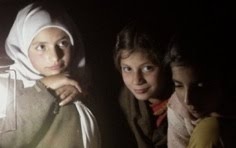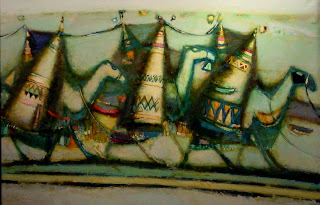 I am privileged to share here the work of one of my Story workshop participants,
I am privileged to share here the work of one of my Story workshop participants,Parvez Daruwala, who works as a trainer and facilitator with corporates and other groups. Parvez had done insightful work on a childhood favorite story, that he discovered, to his surprise, had unconsciously shaped so much of his response to people and events in his life, even today -- as indeed many of us exploring favorite childhood tales often find out! Parvez generously agreed to share his work with us here.
The Elephant and the Tailor
(Regular Version I heard and loved as a child)
An elephant and his mahout in a village would go from place to place seeking alms etc. People would give money or eatables. Once, a tailor, instead of giving something, pricked the elephant’s trunk with a needle. He did this the next day too. The third day the elephant arrives and again the tailor hurts him, so the elephant fills his trunk with dirty water and pours this on the garments which the tailor was stitching for the King’s daughter. The King punishes the tailor for his carelessness, and also for his cruelty to the elephant.
Moral that I picked up: Tit for Tat
The Elephant and the Tailor –
(Revised Version after the “Storywork and Healing” Session)
by Parvez J Daruwala
Once, in a small town, a Mahout used to take his elephant from door to door to seek alms. People loved the elephant and respected the Mahout who was kind and respectful to all. They would thus give eatables to the elephant like fruits which the elephant would sometimes eat and sometimes share with his keeper. When people would give money, he’d give it to his Mahout
Life was peaceful and they did not worry about the next day or next meal. They lived from day to day, trusting that their daily needs would be provided for by the village people.
One day, when the elephant, whom we will call Ramu, approached the town’s tailor, the tailor being in a foul mood, pricked a needle in Ramu’s trunk. The Gentle yet Mighty Creature was stunned with the pain and more so shocked at the violent act of the tailor. Ramu and the Mahout left silently. The second day too, the tailor pricked the needle to his trunk and Ramu and the Mahout withdrew, sadly.
Now Ramu was puzzled by this behavior of the tailor. He thought and pondered, he shed some tears and he sighed some more and he put himself in the tailor’s place and imagined why the tailor was angry. An idea came to him, He smiled, and it’s wonderful to see a smile on an elephant. He glowed with an Inner Light and on the third day when they were reaching the tailor’s shop, his Mahout urged him to walk away and not stop there. But Ramu went up to the tailor’s shop and as the tailor approached with a frown and the needle, Ramu presented him with a bunch of beautiful flowers. The surprised tailor forgot to prick him with the needle as he stretched his hand to take the flowers!
And then the next day, Ramu gave the tailor a ripe mango he had plucked from a wayside tree and the day after that, it was a shining stone and so on. The tailor was touched with Ramu’s forgiveness, acceptance and love. And generosity.
He praised the elephant to all and sundry and all in turn also praised his keeper, the Mahout, for inculcating such noble values in mighty Ramu
Then one day, when Ramu and the Mahout visited the tailor, the tailor presented Ramu with a beautiful red and gold embroidered cloth to cover his head and back. The elephant received it with grace and gratitude and passed it onto his Keeper who draped it over Ramu. The elephant took-on a new regal look. It stopped feeling like a beggar
Every time someone gave him something, Ramu would now raise his trunk in blessing, touch the person and they would be healed and feel whole again. The more love and joy, riches and respect came to Ramu and His Mahout, the Keeper. And the more blessings they gave to those who offered them their offerings. And also to those who did not. And the village was transformed into a lovely world where all helped each other, respected and loved others and lived forever in joy.
Parvez J Daruwala also added this explanation:
Hello Marguerite
… Let me try and explain my working with this story.
In the first, regular version, the elephant throws dirty water on the tailor on being pricked by the needle and it’s like tit for tat. While putting myself in the story - in the skin of the elephant, I realized that when hurt I have a tendency to react with anger and annoyance … and retaliation.
Once, in a small town, a Mahout used to take his elephant from door to door to seek alms. People loved the elephant and respected the Mahout who was kind and respectful to all. They would thus give eatables to the elephant like fruits which the elephant would sometimes eat and sometimes share with his keeper. When people would give money, he’d give it to his Mahout
Life was peaceful and they did not worry about the next day or next meal. They lived from day to day, trusting that their daily needs would be provided for by the village people.
One day, when the elephant, whom we will call Ramu, approached the town’s tailor, the tailor being in a foul mood, pricked a needle in Ramu’s trunk. The Gentle yet Mighty Creature was stunned with the pain and more so shocked at the violent act of the tailor. Ramu and the Mahout left silently. The second day too, the tailor pricked the needle to his trunk and Ramu and the Mahout withdrew, sadly.
Now Ramu was puzzled by this behavior of the tailor. He thought and pondered, he shed some tears and he sighed some more and he put himself in the tailor’s place and imagined why the tailor was angry. An idea came to him, He smiled, and it’s wonderful to see a smile on an elephant. He glowed with an Inner Light and on the third day when they were reaching the tailor’s shop, his Mahout urged him to walk away and not stop there. But Ramu went up to the tailor’s shop and as the tailor approached with a frown and the needle, Ramu presented him with a bunch of beautiful flowers. The surprised tailor forgot to prick him with the needle as he stretched his hand to take the flowers!
And then the next day, Ramu gave the tailor a ripe mango he had plucked from a wayside tree and the day after that, it was a shining stone and so on. The tailor was touched with Ramu’s forgiveness, acceptance and love. And generosity.
He praised the elephant to all and sundry and all in turn also praised his keeper, the Mahout, for inculcating such noble values in mighty Ramu
Then one day, when Ramu and the Mahout visited the tailor, the tailor presented Ramu with a beautiful red and gold embroidered cloth to cover his head and back. The elephant received it with grace and gratitude and passed it onto his Keeper who draped it over Ramu. The elephant took-on a new regal look. It stopped feeling like a beggar
Every time someone gave him something, Ramu would now raise his trunk in blessing, touch the person and they would be healed and feel whole again. The more love and joy, riches and respect came to Ramu and His Mahout, the Keeper. And the more blessings they gave to those who offered them their offerings. And also to those who did not. And the village was transformed into a lovely world where all helped each other, respected and loved others and lived forever in joy.
Parvez J Daruwala also added this explanation:
Hello Marguerite
… Let me try and explain my working with this story.
In the first, regular version, the elephant throws dirty water on the tailor on being pricked by the needle and it’s like tit for tat. While putting myself in the story - in the skin of the elephant, I realized that when hurt I have a tendency to react with anger and annoyance … and retaliation.
This may manifest in a shouting match with the other person or a silent sulk which lasts for a couple of days. This behavior normally is more with one’s own family - while at work or in social situation, one is more docile, or diplomatic.
I saw parallels with the elephant story -- and this insight kind of jolted me.
So then it struck me that why not have a different ending to the story. Then when you asked us to re write the story, I just did it this way.
I am more aware of my thoughts and emotions and reactions. I try not to react but to respond instead more calmly and peacefully. I think that has been the shift within, It’s not like I am completely changed at one stroke, but I know its just one step towards the 1000 mile journey.
…. Seeing myself as every character in my story (elephant, tailor, mahout and even needle) and how it affected me, gave me insights as I looked at it from the perspective of being the different characters… including being the new clothes being stitched and the dirty water thrown. I see at the end of two days, applications for my personal growth, in my quest for inner peace, fulfillment, joy and abundance.
Parvez
I saw parallels with the elephant story -- and this insight kind of jolted me.
So then it struck me that why not have a different ending to the story. Then when you asked us to re write the story, I just did it this way.
I am more aware of my thoughts and emotions and reactions. I try not to react but to respond instead more calmly and peacefully. I think that has been the shift within, It’s not like I am completely changed at one stroke, but I know its just one step towards the 1000 mile journey.
…. Seeing myself as every character in my story (elephant, tailor, mahout and even needle) and how it affected me, gave me insights as I looked at it from the perspective of being the different characters… including being the new clothes being stitched and the dirty water thrown. I see at the end of two days, applications for my personal growth, in my quest for inner peace, fulfillment, joy and abundance.
Parvez
Only by recognizing our unconscious patterns of behavior
and consciously exploring the personal, familial,
and cultural myths underlying them
can we be begin to evolve more effective and creative relationships
with ourselves, others, and the world.













